1995 HONDA ODYSSEY steering wheel
[x] Cancel search: steering wheelPage 13 of 240
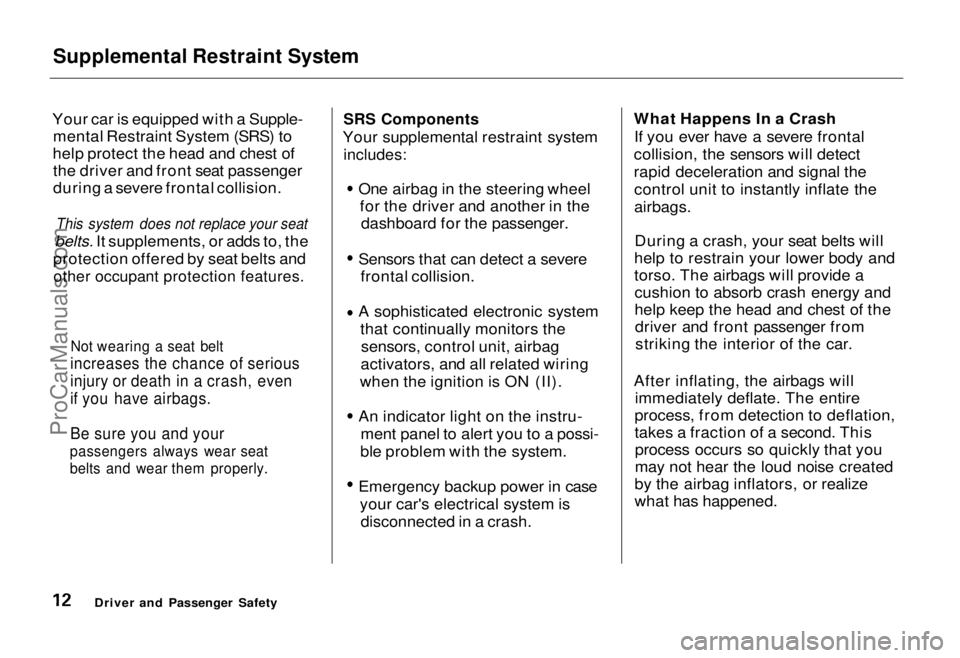
Supplemental Restraint System
Your car is equipped with a Supple- mental Restraint System (SRS) to
help protect the head and chest of the driver and front seat passenger
during a severe frontal collision.
This system does not replace your seat
belts. It supplements, or adds to, the
protection offered by seat belts and
other occupant protection features.
SRS Components
Your supplemental restraint system
includes:
One airbag in the steering wheelfor the driver and another in thedashboard for the passenger.
Sensors that can detect a severe frontal collision.
A sophisticated electronic system that continually monitors thesensors, control unit, airbag
activators, and all related wiring
when the ignition is ON (II).
An indicator light on the instru- ment panel to alert you to a possi-
ble problem with the system.
Emergency backup power in case your car's electrical system isdisconnected in a crash. What Happens In a Crash
If you ever have a severe frontal
collision, the sensors will detect
rapid deceleration and signal the control unit to instantly inflate the
airbags.
During a crash, your seat belts will
help to restrain your lower body and
torso. The airbags will provide a cushion to absorb crash energy and
help keep the head and chest of thedriver and front passenger fromstriking the interior of the car.
After inflating, the airbags will immediately deflate. The entire
process, from detection to deflation,
takes a fraction of a second. This process occurs so quickly that you
may not hear the loud noise created
by the airbag inflators, or realize
what has happened.
Driver and Passenger Safety
Not wearing a seat belt
increases the chance of serious
injury or death in a crash, even
if you have airbags.
Be sure you and your
passengers always wear seat
belts and wear them properly.ProCarManuals.comMain Menu Table of Contents s t
Page 15 of 240
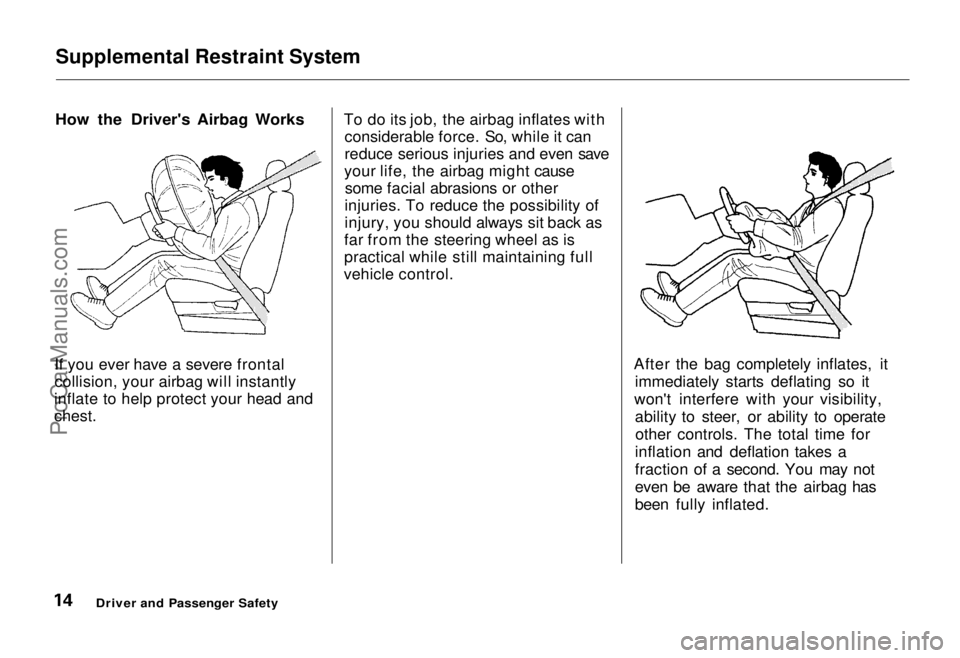
Supplemental Restraint System
How the Driver's Airbag Works
If you
ever have a severe frontal
collision, your airbag will instantly
inflate to help protect your head and
chest.
To do its job, the airbag inflates with
considerable force. So, while it can
reduce serious injuries and even save
your life, the airbag might cause some facial abrasions or other
injuries. To reduce the possibility of
injury, you should always sit back as
far from the steering wheel as is
practical while still maintaining full
vehicle control.
After the bag completely inflates, itimmediately starts deflating so it
won't interfere with your visibility, ability to steer, or ability to operateother controls. The total time for
inflation and deflation takes a
fraction of a second. You may not
even be aware that the airbag has
been fully inflated.
Driver and Passenger SafetyProCarManuals.comMain Menu Table of Contents s t
Page 16 of 240

Supplemental Restraint System
The driver's airbag is stored in the center of the steering wheel. For
your safety, do not attach any items to the steering wheel. They could
interfere with the proper operation of the airbag. Or, if the airbag
inflates, they could be propelled
inside the car and hurt someone. How the Passenger's Airbag
Works
If you ever have a severe frontal
collision, the passenger's airbag will
inflate at the same time as the driver's
airbag.
This airbag is quite large and inflates
with considerable force. It can seriously hurt a front seat passenger
who is not in the proper position and
wearing the seat belt properly. Front seat passengers should move theseat as far back as practical and sit
well back in the seat.
We strongly recommend that you do not put an infant seat in the front
passenger's seat. If the airbag inflates, it can hit the infant seat with
great force. The infant seat can be dislodged or struck with enough
force to cause very serious injury to
the infant.
If a toddler seat is used in the front
passenger's seat, the vehicle seatshould be moved as far back as
possible. If the passenger's bag
inflates, it could seriously hurt a
toddler who is not in the proper position or properly restrained.
CONTINUED
Driver and Passenger SafetyProCarManuals.comMain Menu Table of Contents s t
Page 18 of 240

Supplemental Restraint System
System Service Precautions
Do not modify your steering wheel or any other part of the supplemental
restraint system. Modifications could
make the system ineffective.
Do not tamper with the system's
components or wiring. This could
cause the airbags to inflate inadver-
tently, possibly injuring someone
very seriously.
Tell anyone who works on your car that you have a supplemental
restraint system. Failure to followthe procedures and precautions in
the official Honda service manualcould result in personal injury or
damage to the system. Scrapping an entire car that has an
uninflated airbag can be dangerous.
Get assistance from a Honda dealer
if your car must be scrapped.
If you sell your car, please be sure to
tell the new owner that the car has a supplemental restraint system. Alert
them to the information and precau-
tions in this part of the owner's
manual.
Driver and Passenger SafetyProCarManuals.comMain Menu Table of Contents s t
Page 33 of 240
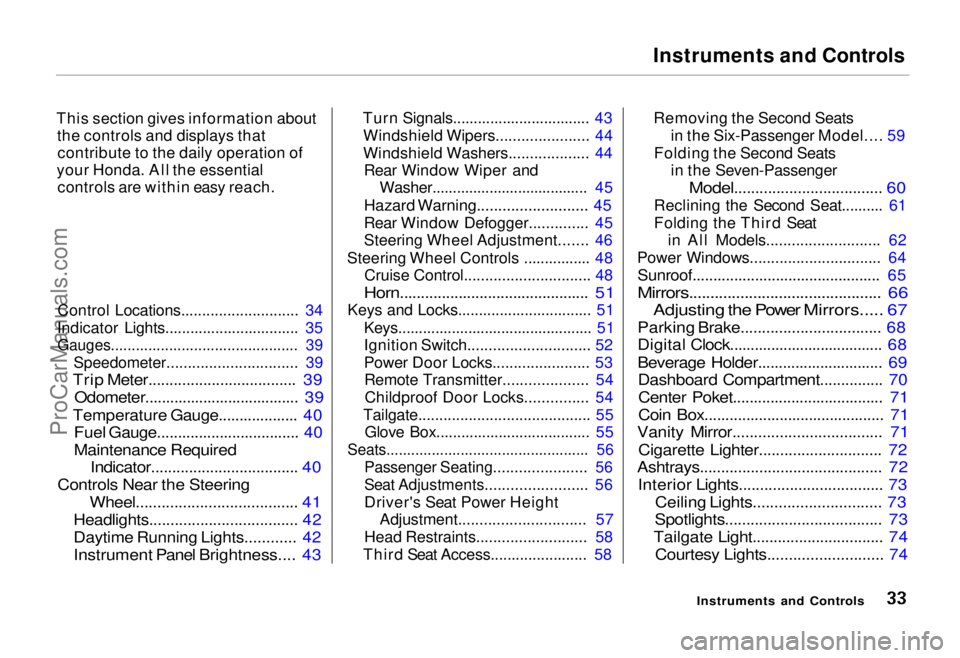
Instruments and Controls
This section gives information about the controls and displays thatcontribute to the daily operation of
your Honda. All the essential controls are within easy reach.
Control Locations............................ 34
Indicator Lights................................ 35
Gauges............................................. 39
Speedometer............................... 39
Trip Meter................................... 39
Odometer..................................... 39
Temperature Gauge................... 40
Fuel Gauge.................................. 40
Maintenance Required
Indicator................................... 40
Controls Near the Steering Wheel...................................... 41
Headlights...................................
42
Daytime Running
Lights............ 42
Instrument Panel Brightness.... 43
Turn Signals................................. 43
Windshield Wipers...................... 44
Windshield Washers................... 44 Rear Window Wiper and Washer...................................... 45
Hazard Warning.......................... 45
Rear Window Defogger.............. 45
Steering Wheel Adjustment....... 46
Steering Wheel Controls ................ 48 Cruise Control.............................. 48
Horn............................................. 51
Keys and Locks................................ 51
Keys............................................... 51
Ignition Switch............................. 52
Power Door Locks....................... 53Remote Transmitter.................... 54
Childproof Door Locks............... 54
Tailgate......................................... 55 Glove Box..................................... 55
Seats................................................. 56
Passenger Seating...................... 56
Seat Adjustments........................ 56
Driver's Seat Power HeightAdjustment.............................. 57
Head Restraints.......................... 58
Third Seat Access....................... 58 Removing the Second Seats
in the Six-Passenger Model.... 59
Folding the Second Seats in the Seven-Passenger
Model................................... 60
Reclining the Second Seat.......... 61
Folding the Third Seat in All Models...........................
62
Power Windows.............................. .
64
Sunroof............................................. 65
Mirrors............................................. 66
Adjusting the Power Mirrors.....
67
Parking Brake.................................
68
Digital Clock..................................... 68
Beverage Holder.............................. 69 Dashboard Compartment............... 70
Center Poket.................................... 71
Coin Box........................................... 71
Vanity Mirror................................... 71
Cigarette Lighter............................. 72
Ashtrays........................................... 72
Interior Lights.................................. 73
Ceiling Lights.............................. 73
Spotlights..................................... 73
Tailgate Light............................... 74 Courtesy Lights........................... 74
Instruments and ControlsProCarManuals.comMain Menu s t
Page 41 of 240

Controls Near the Steering Wheel
The two levers on the steering column contain controls for driving
features you use most often. The left lever controls the turn signals,headlights, and high beams. The
right lever controls the windshield
wipers.
The rear window defogger switch and hazard warning switch are on
the dashboard under the center air
vent.
The controls near the left air vent are for the sunroof, cruise control
and instrument panel brightness.
The lever on the underside of the steering column allows you to tilt the
steering wheel.
Instruments and Controls
HAZARD WARNING LIGHT
SHIFT LEVER
REAR WINDOW
DEFOGGER
SUNROOF
SWITCH
WINDSHIELD
WIPERS/WASHERS
TILT
ADJUSTMENT
HEADLIGHTS/
TURN SIGNALS
INSTRUMENT
BRIGHTNESS
CRUISE
CONTROLProCarManuals.comMain Menu Table of Contents s t
Page 42 of 240
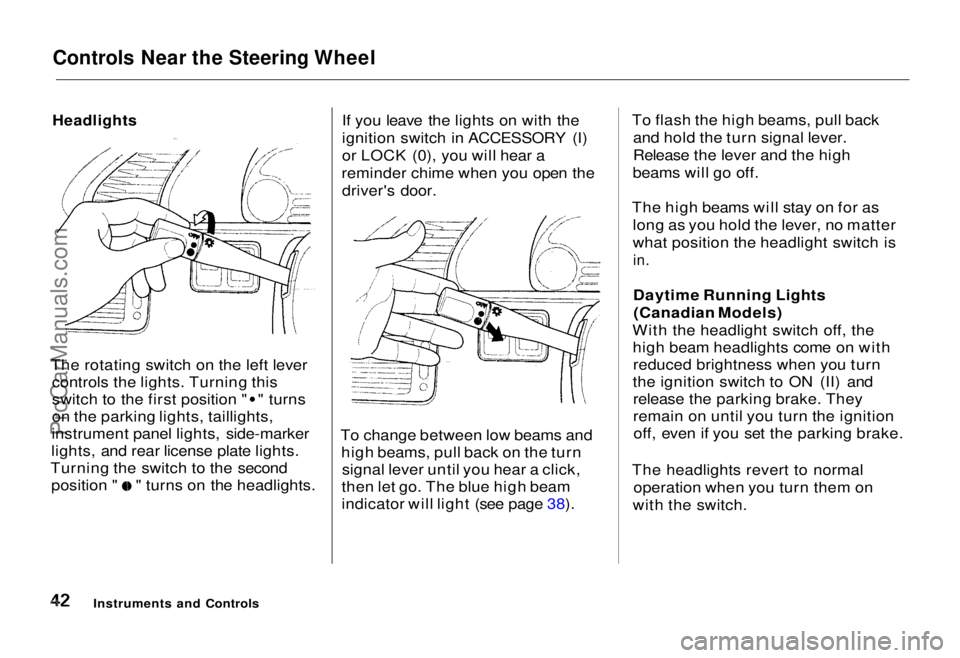
Controls Near the Steering Wheel
The rotating switch on the left lever controls the lights. Turning this switch to the first position " " turns
on the parking lights, taillights,
instrument panel lights, side-marker
lights, and rear license plate lights.
Turning the switch to the second position " " turns on the headlights. If you leave the lights on with the
ignition switch in ACCESSORY (I)
or LOCK (0), you will hear a
reminder chime when you open the driver's door.
To change between low beams and high beams, pull back on the turnsignal lever until you hear a click,
then let go. The blue high beam
indicator will light (see page 38). To flash the high beams, pull back
and hold the turn signal lever.
Release the lever and the high
beams will go off.
The high beams will stay on for as long as you hold the lever, no matter
what position the headlight switch is
in.
Daytime Running Lights(Canadian Models)
With the headlight switch off, the high beam headlights come on withreduced brightness when you turn
the ignition switch to ON (II) and release the parking brake. They
remain on until you turn the ignitionoff, even if you set the parking brake.
The headlights revert to normal operation when you turn them on
with the switch.
Instruments and Controls
HeadlightsProCarManuals.comMain Menu Table of Contents s t
Page 43 of 240
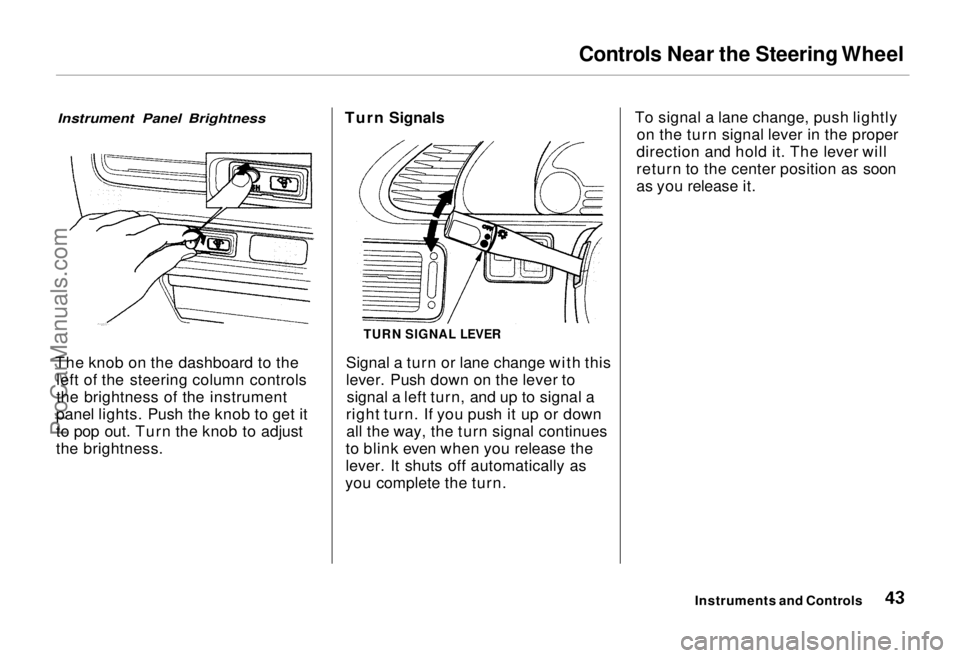
Controls Near the Steering Wheel
Instrument Panel Brightness
The knob on the dashboard to the left of the steering column controls
the brightness of the instrument
panel lights. Push the knob to get it
to pop out. Turn the knob to adjust
the brightness. Turn Signals
Signal a turn or lane change with this
lever. Push down on the lever tosignal a left turn, and up to signal a
right turn. If you push it up or down all the way, the turn signal continues
to blink even when you release the
lever. It shuts off automatically as
you complete the turn. To signal a lane change, push lightly
on the turn signal lever in the proper
direction and hold it. The lever will
return to the center position as soon
as you release it.
Instruments and Controls
TURN SIGNAL LEVERProCarManuals.comMain Menu Table of Contents s t